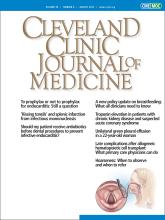Table of Contents
From the Editor
- To prophylax or not to prophylax for endocarditis: Still a question
Give prophylactic antibiotics before invasive dental procedures? On the surface, it may seem sensible. But we have more to learn about the successful clearance of bacteria from the bloodstream and why protective mechanisms occasionally fail.
The Clinical Picture
- ‘Kissing tonsils’ and splenic infarction from infectious mononucleosis
A 36-year-old male presented with severe pain in the left upper quadrant after 10 days of cough, sore throat, and fever.
1-Minute Consult
- Getting to the root of the problem: Should my patient receive antibiotics before dental procedures to prevent infective endocarditis?
Individual risk depends on inherent patient and procedural risk factors. The authors offer practical points to aid decision-making.
Guidelines to Practice
- A new policy update on breastfeeding: What all clinicians need to know
An overview of current American Academy of Pediatrics policy, directed to clinicians of all disciplines who may interact with breastfeeding mothers and their babies.
Review
- Hoarseness: When to observe and when to refer
A concise, illustrated review of basic laryngeal anatomy and function, symptoms of vocal-fold pathology, and current guidelines from the American Academy of Otolaryngology–Head and Neck Surgery.
- Evaluating troponin elevation in patients with chronic kidney disease and suspected acute coronary syndrome
The authors examine challenges in diagnosing acute coronary syndrome in patients with chronic kidney disease and provide a diagnostic algorithm to risk-stratify these patients.
Symptoms to Diagnosis
- Unilateral green pleural effusion in a 22-year-old woman
Chills, night sweats, palpitations, and a 5-lb weight loss, preceded by 6 months of progressive dyspnea, fatigue, and reduced exercise tolerance. What is the diagnosis?
Review
- Late complications after allogeneic hematopoietic cell transplant: What primary care physicians can do
Cardiovascular, metabolic, endocrine, rheumatologic, orthopedic, infectious, neurologic, and cognitive complications are examined, as well as secondary malignancies, psychiatric disorders, and impairments in quality of life and sexual health.




